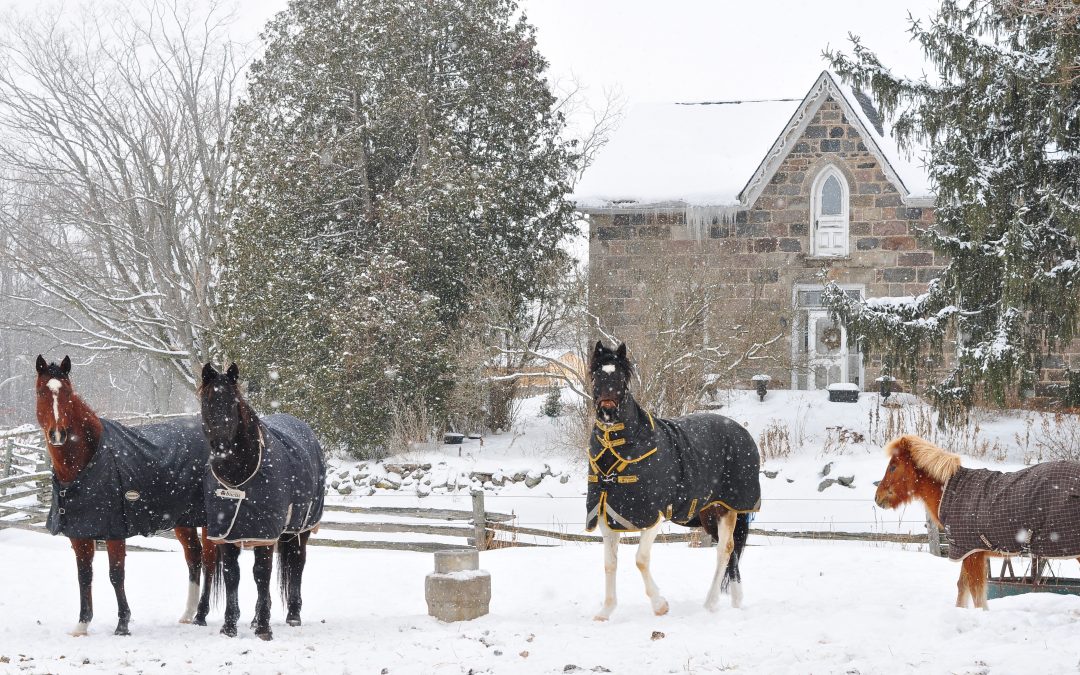Maintain a steady lesson routine – If you have signed up for winter lessons you probably already have this part covered! It is so much harder to learn in bits and spurts. You need to develop a routine in order to make significant change in your riding and/or your horse’s training. The exception to this rule is very young children who cannot keep warm enough to enjoy winter riding. There is no better way to turn a 5 year old off of riding than turn them into a popsicle on horseback over and over again! Some kids thrive in the cold too, know which type yours is!
Invest in the right equipment – Rubber boots and a helmet from the riding school are perfectly fine for brand new riders just testing out the waters to see if horseback riding is for them. Beyond that, and into any subsequent sessions of lessons, it is a good idea to invest in some proper riding footwear, half chaps, gloves and a helmet. You do not need to break the bank on these! There are many great affordable options now and second hand is an awesome way to go for footwear and chaps, especially since kids grow so fast! Helmets however should always be purchased new (and long hair should always be tied back in a low pony tail or similar while riding). Two of the most important things your instructor will be looking for you to demonstrate are that your weight is down in your heels and your lower leg is tight on your horses side. If your boots are too stiff at the ankles to bend and your riding pants are not protecting you from leg rubs or pinching from your stirrup leathers when you grip, then your equipment is working against you, not for you!
Layer Up! – Base layers are your best friend! Invest in quality base layers (top and bottom), good wool socks, winter gloves and boots or boots with enough room to comfortably fit thick socks. Thin rubber boots will offer little to no protection against the cold and do not breathe well. Overly tight boots will restrict blood flow and will cause real discomfort. Add a vest or fleece zip up and a jacket so that you can add or remove layers as you warm up through your ride. Coats should be short and zipped up so that they aren’t flapping, catching on your saddle or hiding your position from your instructor.
Trust Your Instructor – Your instructors make their lessons plans and horse selections based on the level of your riding, the horses work load and specific horse requests from over 200 riders a week. This means that you will not always be riding your favourite horse or pony in your lesson. But remember, every single horse you ride has something to teach you and your instructor has selected the horse or pony most suited to teach you what you need to learn on that day. Keep an open mind, trust their selection and make the best of learning how to ride a variety of horses. That is what real horsemanship and sportsmanship is all about!
Arrive with enough time to get ready and into the ring on time – This one is pretty obvious, but if you are constantly arriving just 5 minutes before your lesson time and not leaving enough time to catch, groom and tack up your horse or pony to start your lesson on time, you will be missing out not only on valuable minutes of your lesson time, but also on the bonding time that grooming your horse properly and methodically provides. Our instructors want to do the warm-up with you in order to guide you in a way that is most suitable for you and your horse and to start you off with exercises that help you or your horse with specific difficulties. They will also give you ideas on what to do when riding on your own. As you become a more advanced rider, there may be times when you are asked to be warmed up and ready to go before the start of your lesson. This gives you more time for the learning part of the lesson, where you can try new things or reinforce things you are still working on. The bottom line is, be ready. Get in the ring before the lesson is scheduled to start. Have all your tack adjusted and secured and be on the horse and walking by the time your instructor is ready for you. For beginner riders, start practising how to adjust your stirrups and tighten your girth before you leave the cross ties, the first minutes of your lesson will still be spent checking over these things but we love to see that you are trying on your own too.
Really Try Your Best – There is an art to being a good student. Your instructor can make all kinds of brilliant suggestions for how to improve your riding, but only YOU can physically make those changes happen. We cannot will you to look into your corners or put your weight down in your heels. Only you can do that. Show your instructor that you are really trying to perform the exercises and adjustments they ask for, even if you aren’t yet able to maintain the change, show us that you are trying. You will be blown away by how much faster you will progress and how much more you are able to do in your lessons when you really put some physical grit and effort into it.
Try even if you think you can’t do it – This happens all the time! Your instructor might tell you to do something and all you can think is, I can’t do that! Or maybe you think, I’ve never done that, we’re not ready! In any case, give it your best shot. You’ll realize that your instructor is likely not going to push you so far out of your comfort zone that the skill will be impossible for you. There is no other way to expand your horizons, so just go with it. Most skills take a long time (years maybe) to really develop, so just get started and work on what you get. We all go through self-doubt, especially when faced with new learning.
Watch your fellow riders– Group lesson are our favourite format because there are so many opportunities to learn from others. Watch the other riders in your group when waiting for your turn. Listen to the instruction your coach is giving them and assess whether or not you can apply that instruction to your own ride. It is frustrating and a waste of valuable lesson time when the last rider of the group doesn’t know the course or exercise because they weren’t watching the riders ahead of them.
Read – You can’t learn to ride by reading. However, reading is an excellent addition to your practical lessons. There isn’t always enough time in a lesson to go into detailed explanations – and that is where books (and blogs!) can fit into your learning program. You might be able to pick something up theoretically that you can later use during your ride. If you are prepared with some knowledge, you might be able to pick up the meaning of your instructor’s directions quicker than if you have no background whatsoever. For young beginner riders, there are so many great books out there geared towards horse kids! You can solidify your knowledge of horse breeds, colours, tack and equipment and so much more through picture books all while curled up on the couch with a blanket and a hot drink! Such books can often be found very affordably second hand at thrifts stores.

